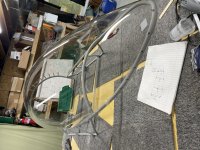Lucky Aviation
Member
My friend who is an engineer and in the industrial plastics business guided me with heat treating my canopy to reduce stress.
I carefully measured the frame when installed on the airplane track and installed temporary bracing on the frame to keep things exactly where they need to be. We placed the canopy in an oven which is designed to anneal plastics. We brought the temperature up slowly to 190 degrees, maintained it for 2 hours and brought the temperature down very slowly.
I removed the clecos and the plastic fits the canopy frame perfectly with zero stress.
After going through this process, I believe that a simple homemade oven can be made up with some basic materials to accomplish this without spending a ton of money.
I was just lucky to know a guy who knows what he is doing and has a set up already.
I thought that it may help someone who is worried about too much stress on the plastic when riveting it to the frame, which may invite cracks.
I carefully measured the frame when installed on the airplane track and installed temporary bracing on the frame to keep things exactly where they need to be. We placed the canopy in an oven which is designed to anneal plastics. We brought the temperature up slowly to 190 degrees, maintained it for 2 hours and brought the temperature down very slowly.
I removed the clecos and the plastic fits the canopy frame perfectly with zero stress.
After going through this process, I believe that a simple homemade oven can be made up with some basic materials to accomplish this without spending a ton of money.
I was just lucky to know a guy who knows what he is doing and has a set up already.
I thought that it may help someone who is worried about too much stress on the plastic when riveting it to the frame, which may invite cracks.





